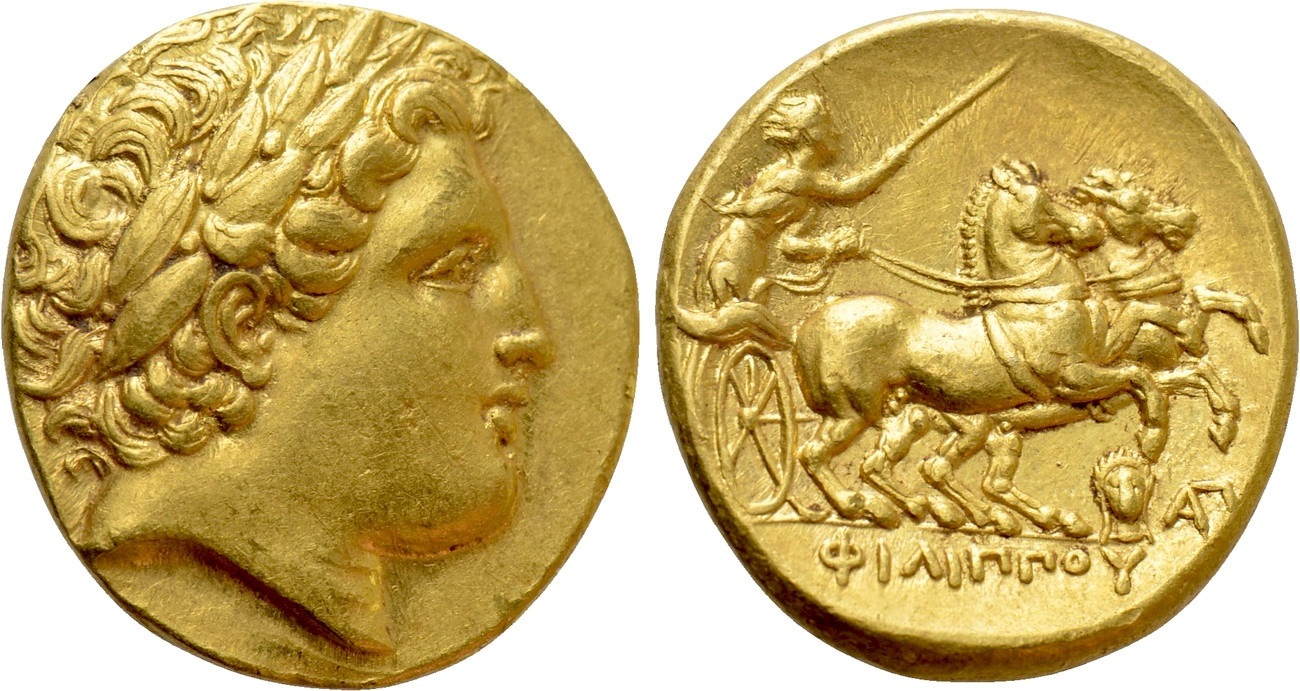Lampsacus (Philip II), gold, staters (323-317 BCE)
From SILVER
323 BCE - 317 BCE Gold 57,815 kg
Description
| ObverseInscription or printing placed on the obverse.: | Head of Apollo right, wearing laurel wreath. |
| ReverseInscription or printing placed on the reverse.: | ΦΙΛΙΠΠΟΥ (Greek).Charioteer driving biga right. Controls: below, facing head of Helios and monogram. |
Mint and issuing power
| MintIdentifies the place of manufacture or issue of a numismatic object.: | Lampsacus | Ancient regionAncient region.: | Mysia | Modern countryModern country: Turkey | AuthorityIdentifies the issuing power. The authority can be "pretended" when the name or the portrait of X is on the coin but he/she was not the issuing power. It can also be "uncertain" when there is no mention of X on the coin but he/she was the issuing power according to the historical sources: | Philipp III Arrhidaeus (Argead king, 323-317 BC) |
Chronology
| FromIdentifies the initial date in a range assigned in a numismatic context. | 323 BCE | toIdentifies the final date in a range assigned in a numismatic context.. | 317 BCE | PeriodTime period of the numismatic object.: Hellenistic 323-30 BC |
Physical description
| MetalThe physical material (usually metal) from which an object is made.: | Gold |
Median weightMedian of the weights of numismatic objects (in grams). in grams | 8.55 | DenominationTerm indicating the value of a numismatic object. Examples: tetradrachm, chalkous, denarius.: | stater |
StandardStandard.: | Attic |
Image

RQEMH 201 - Lampsacus, gold, stater, 323-317 BC.jpg [1]
References
| Die study referencePublication of the study: | Thompson 19911Thompson 1991 | ||
| Coin series referenceReference to coin series study: | Sear II2Sear II, n° 6661-6664, RQEMH3RQEMH, n° 201 | ||
Obverse dies distribution
| FrequencyFrequency of specimen in distribution. ᵖ | Number of obversesNumber of obverse dies. ᵖ (o) | % (o) | Number of coinsNumber of coins. (n) | % (n) | Die nameName(s) of the die(s). |
| 1 | 10 | 35.71 | 10 | 10.2 | 109, l l l, 117, 120, 123, 124, 153, 154, 156, 172 |
| 2 | 4 | 14.29 | 8 | 8.16 | 115, 119, 121, 158 |
| 3 | 6 | 21.43 | 18 | 18.37 | 112, 113, 157, 167, 168, 169 |
| 4 | 3 | 10.71 | 12 | 12.24 | 114, 122, 155 |
| 5 | 2 | 7.14 | 10 | 10.2 | 110, 125 |
| 10 | 1 | 3.57 | 10 | 10.2 | 126 |
| 11 | 1 | 3.57 | 11 | 11.22 | 118 |
| 19 | 1 | 3.57 | 19 | 19.39 | 116 |
| Total | 28 of 28 | 99.99 | 98 of 98 | 99.98 |
Reverse dies distribution
no distribution is available
Quantification
| Number of obversesNumber of obverse dies. ᵖ (o) | 28 | Number of singletons (o1)The number of singleton coins. ᵖ | 10 |
| Number of reverse diesNumber of reverse dies. (r) | 35 | Number of coinsNumber of coins. (n) | 98 |
| Coins per obverse dieNumber of coins per obverse die. (n/o) | 3.5 | Coins per reverse dieNumber of coins per reverse die. (n/r) | 2.8 |
| Reverse per obverse ratioRatio of obverse dies divided by reverse dies. (r/o) | 1.25 | Percentage of singletons (o1)number of coins (n) divided by the number of singletons (o1) ᵖ | 35.71 % |
| Original number of dies (O) (Carter 1983 formula)The estimation of the number of coins according to Carter 1983 ᵖ | 33.81 | Coins struck if 20,000 as average productivity per dieCoins made if the average productivity for obverses (according to Carter) is 20,000. ᵖ | 676,200 |
| Original number of dies (O) (Esty 2011 formula)The estimation of the number of coins according to the singleton formula in Esty 2011 ᵖ (O) | 39.2 | Survival rate if 20,000 as average productivity per dieSurvival rate if average productivity is 20,000. ᵖ | 0.00014 |
| Coverage (o = % of O) (Esty 1984 formula)Esty 1984 - coverage (% of O) ᵖ (o = % of O) | 89.8% | Die productivity if survival rate 1/2,000Average productivity if survival rate is 1/2,000. ᵖ | 5,797.1 |
| Weight of silver (in kg) if 20,000 coins per die (O = Carter formula)Carter 1983 * Median weight * 20000 (*10 if gold or electrum) ᵖ | 57,815 kg <br /> 57,815 kg | Die productivity if survival rate 1/5,000Average productivity if survival rate is 1/5,000. ᵖ | 14,492.75 |
Remarks
Most likely one single workstation
References
- ^ Thompson, Margaret (1991), Alexander's Drachm Mints. II : Lampsacus and Abydus, New York.
- ^ Sear, David R. (1979), Greek coins and their values. Vol. II, Asia and North Africa, London, xlviii, p. 317-762
- ^ Callataÿ, François de (1997), Recueil quantitatif des émissions monétaires hellénistiques, Numismatique Romaine, Wetteren, X + 341 p.